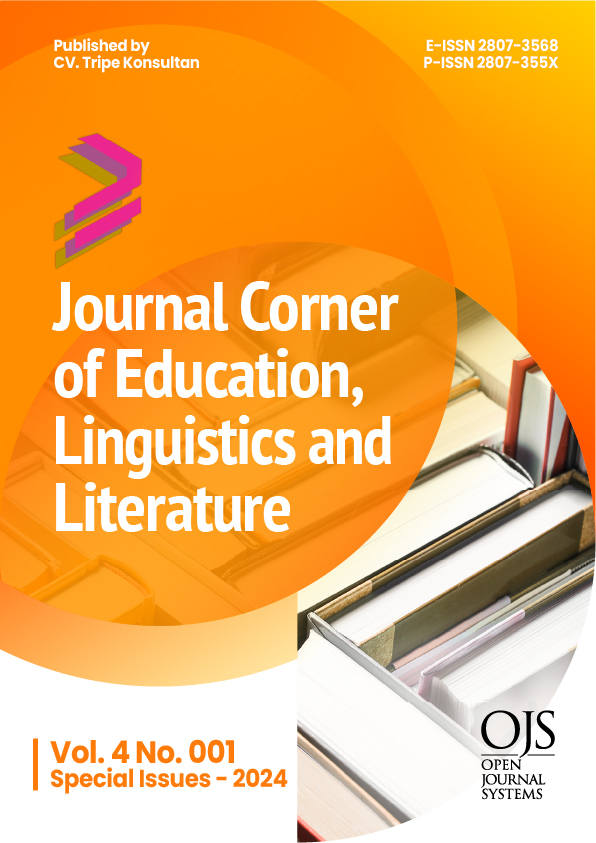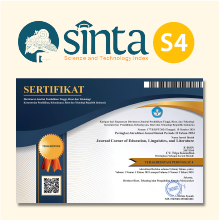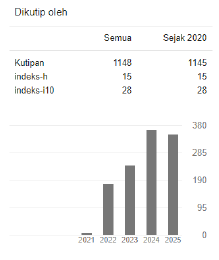Negation Form in Tidung Language
 https://doi.org/10.54012/jcell.v4i001.455
https://doi.org/10.54012/jcell.v4i001.455
 Abstract views: 71
Abstract views: 71
 PDF downloads: 91
PDF downloads: 91
Keywords:
Negation, Tidung , Syntax, ClauseAbstract
In daily communication, Tidung speakers often utilize negation forms for rejection, cancellation, and negation. This linguistic phenomenon is very interesting to study. This paper aims to describe the form of negation in Tidung language and its usage. This study of negation in Tidung language uses descriptive method. The source of data comes from written and spoken discourse, especially those that contain the use of negation forms. The data were collected using reading, note-taking, and interview techniques. The data analysis technique used is qualitative descriptive analysis technique. In this paper, several forms of negation in Tidung language are found, including negation of kamad, ando, sama and kamad sino. These forms of negation have different functions and meanings. The use of negation in Tidung language can occur in parts of sentences contained in compound sentences and in the whole sentence contained in single sentences. Judging from the rigidity of the location, the five negations are very strong because the position of the negation cannot be moved to the right of the predicate function or to the left of the subject and object functions.
Downloads
References
Alwi, H. (2019). Tata Bahasa Baku Bahasa Indonesia. Balai Pustaka.
Aqromi, N. L., & Hendrawan, F. (2018). Bahasa Tidung di Kalimantan Utara: Sebuah Tinjauan dari Perspektif Diakronis. KEMBARA: Jurnal Keilmuan Bahasa, Sastra, Dan Pengajarannya (e-Journal), 4(2), 200–207.
Aswaradini, W. (2013). Bahasa Tidung Di Kabupaten Nunukan Kalimantan Utara: Kajian Linguistik Diakronis (Unpublished Thesis). Universitas Gadjah Mada.
Ba’dulu, A. M. (2005). Herman. 2005. In Morfosintaksis. Jakarta: Rineka Cipta.
Beech, M. W. H. (1908). The Tidong Dialects of Borneo. Clarendon Press.
Chaer, A., & Muliastuti, L. (2014). Makna dan Semantik. Semantik Bahasa Indonesia, 1–39.
Creswell, J. W. (2010). Research Design Pendekatan Kualitatif, Kuantitatif, dan Mixed. Yogyakarta: Pustaka Pelajar.
Fathonah, S., & Romadhan, A. D. (2021). Active and Passive Voice In Bulungan Language. Rainbow: Journal of Literature, Linguistics and Culture Studies, 10(2), 96–105.
Hasibuan, I. A. (2020). Bentuk Negasi Dalam Bahasa Mandailing. Madah: Jurnal Bahasa Dan Sastra, 11(2), 195–204.
Lelo Lein, A., & Bere Nahak, K. (2023). Konstruksi Negasi Bahasa Dawan. Jubindo: Jurnal Ilmu Pendidikan Bahasa Dan Sastra Indonesia, 8(03), 1–10. https://doi.org/10.32938/jbi.v8i03.6041
Mahsun, M. (2017). Metode Penelitian Bahasa. Tahapan, Strategi, Metode, dan Tekniknya. Rajawali Press.
Masfufah, N. (2017). Bentuk Negasi Dalam Bahasa Banua Di Kalimantan Timur. Sawerigading.Kemdikbud.Go.Id, 23(1), 71–79.
Okushima, M. (2003). Ethnic Background of The Tidung: Investigation of The Extinct Rulers of Coastal Northeast Borneo. The Journal of Sophia Asian Studies.
Ramlan, M. (2001). Sintaksis Ilmu Bahasa Indonesia. Yogyakarta: CV Karyano.
Riwut, T. (1993). Kalimantan Membangun, Alam, dan Kebudayaan. Gadjah Mada University Press.
Rizqi, R., Pamuji, S. S., & Romadhan, A. D. (2023). Kalimat Aktif Dan Pasif Dalam Bahasa Daerah Dialek Bone. Jurnal Imbaya, 5(1), 25–35.
Romadhan, A. D. (2020). Serial Verb Construction Of The Dayak Kenyah Lepo’ Tau. Bahasa: Jurnal Keilmuan Pendidikan Bahasa Dan Sastra Indonesia, 2(1), 7–14.
Romadhan, A. D. (2022). Subjek dan Oblik Bahasa Tidung. Cakrawala Linguista, 5(2), 70–78.
Romadhan, A. D., Hakim, L., Selia, A. K. W., Ekasani, K. A., Wuarlela, M., Hiariej, C., Janggo, W. O., Kami, P., Raja, F. D., & Susanti, R. (2023). Pengantar Linguistik Umum. CV. Intelektual Manifes Media.
Romadhan, A. D., & Sari, R. K. (2021). Subjecthood In Punan Tebunyau Language: Kesubjekan Bahasa Punan Tebunyau. Jurnal Kata: Penelitian Tentang Ilmu Bahasa Dan Sastra, 5(2), 224–234.
Selia, A. K. W., & Romadhan, A. D. (2023). Subjecthood in Banjarnese. Indonesian Journal of EFL and Linguistics, 8(2), 263–277.
Sudaryanto. (2018). Metode dan Aneka Teknik Analisis Bahasa: Pengantar penelitian Wahana Kebudayaan Secara Linguistis. Duta Wacana University Press.
Sudaryono, S. (1993). Negasi dalam bahasa Indonesia: suatu tinjauan sintaktik dan semantik. Pusat Pembinaan dan Pengembangan Bahasa.
Syafar, D. N. (2016). Negasi Dalam Bahasa Indonesia dan Bahasa Inggris. Jurnal Arbitrer, 3(1), 1–11.
Downloads
Published
How to Cite
Issue
Section
License
Copyright (c) 2024 Achmad Dicky Romadhan

This work is licensed under a Creative Commons Attribution-ShareAlike 4.0 International License.
All articles published in the Journal Corner of Education, Linguistics, and Literature are licensed under the Creative Commons Attribution-ShareAlike License (CC BY-SA).

















